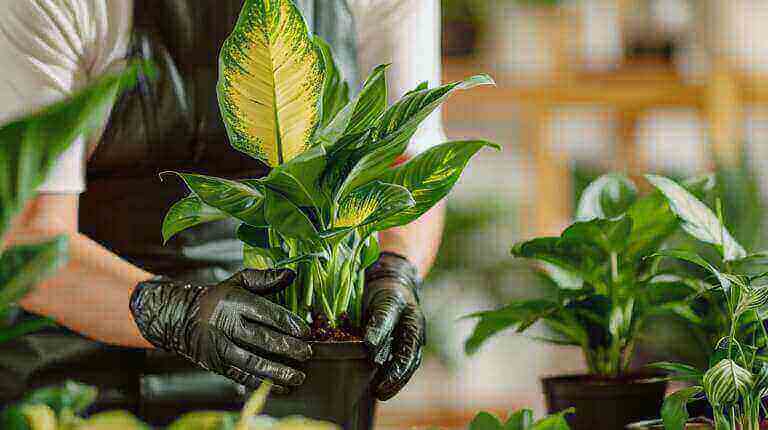Common Dieffenbachia Problems: Dumb Cane Leaves Drooping, Yellow Spots, Root Rot, and How to Fix Them
Dieffenbachia plants are a popular choice for indoor gardening enthusiasts, thanks to their beautiful foliage and ability to thrive in low-light conditions. However, like any plant, dieffenbachia can encounter common problems that can hinder its growth and health. In this article, I will discuss some of the most frequently encountered issues with dieffenbachia plants, including drooping leaves, spots on the leaves, and root rot. I will also provide effective solutions to fix these problems and ensure the longevity of your dieffenbachia plant.
Key Takeaways:
- Dieffenbachia plants can experience drooping leaves, spots on the leaves, and root rot.
- These problems can be caused by factors such as overwatering, fungal or bacterial infections, and pests.
- Identify the symptoms of root rot, including yellowing leaves, wilting, mushy roots, and leaf discoloration.
- To alleviate root rot, stop watering the plant, assess the damage, prune affected roots, treat with fungicides, repot, and provide proper care.
- Prevent root rot by practicing proper watering techniques, using well-draining soil and pots, improving air circulation, and controlling humidity.
Identifying Symptoms of Dieffenbachia Root Rot
Dieffenbachia plants are prone to root rot, a condition that can severely affect their health and vitality. By recognizing the symptoms of root rot early on, you can take prompt action to address the issue and prevent further damage to your plant.
One of the first signs of root rot in dieffenbachia plants is yellowing leaves, particularly the older lower leaves. This discoloration occurs as the roots lose their ability to absorb nutrients and water effectively. In addition to yellowing, wilting and drooping leaves, even when adequately watered, are common indications of root rot. Mushy and discolored roots are clear visual signs of the disease. If you notice a foul odor emanating from the plant, it may also be a strong indication of root rot.
Leaf discoloration is another symptom of root rot in dieffenbachia plants. You may observe brown spots or a dull appearance on the leaves, which is a result of the plant’s inability to absorb nutrients properly due to compromised root health. Identifying these symptoms early on allows you to intervene effectively and implement appropriate measures to treat the root rot.
Table: Symptoms of Dieffenbachia Root Rot
| Symptoms | Visual Indicators |
|---|---|
| Yellowing Leaves | Older lower leaves turning yellow |
| Wilting and Drooping Leaves | Leaves appearing wilted and droopy, even with proper watering |
| Mushy and Discolored Roots | Roots feeling soft and mushy, with a darker or discolored appearance |
| Leaf Discoloration | Brown spots or a dull appearance on the leaves |
| Unpleasant Odors | Foul smell coming from the plant |
Alleviating Dieffenbachia Root Rot
When faced with root rot in your Dieffenbachia plant, it is crucial to take immediate action to alleviate the condition and prevent further damage. Here are the steps you can follow:
- Stop watering: The first and most important step is to stop watering the plant. Overwatering is often the main cause of root rot, so withholding water is necessary to give the plant a chance to recover.
- Assess the damage: Gently unpot the plant and carefully inspect the root system. Look for mushy and discolored roots, as these are clear signs of root rot. Remove any decayed roots using clean and sanitized tools to prevent the spread of the disease.
- Prune affected roots: After assessing the damage, prune the affected roots, removing any sections that are mushy or discolored. Pruning is an essential step to promote healthy regrowth and prevent the spread of the disease.
- Treat with fungicides: In more severe cases of root rot, treating the remaining root system with fungicides can help control the fungal infection. Follow the instructions provided by the fungicide manufacturer for proper application and dosage.
- Repot the plant: Repotting the Dieffenbachia plant in a well-aerated and fast-draining potting mix is recommended. This will help improve the plant’s overall root health and prevent future occurrences of root rot.
- Provide proper care: Once you have addressed the root rot, it’s important to provide proper care for your Dieffenbachia plant. This includes increasing air circulation around the plant, providing bright indirect sunlight, and avoiding overwatering and wetting the leaves.
By following these steps, you can effectively alleviate root rot in your Dieffenbachia plant and promote its recovery. Remember to closely monitor the plant’s progress and make any necessary adjustments to its care routine to ensure its long-term health and vitality.
| Step | Action |
|---|---|
| 1 | Stop watering |
| 2 | Assess the damage |
| 3 | Prune affected roots |
| 4 | Treat with fungicides |
| 5 | Repot the plant |
| 6 | Provide proper care |
To alleviate root rot in Dieffenbachia plants, it is crucial to stop watering the plant. Overwatering is often the main cause of root rot, so withholding water is essential.
Preventing Dieffenbachia Root Rot
Preventing root rot in dieffenbachia plants is crucial to maintaining their health and vitality. By following a few simple guidelines, you can significantly reduce the risk of root rot and ensure the longevity of your plant.
Proper Watering
One of the most important aspects of preventing root rot is proper watering. Dieffenbachia plants prefer moist but not waterlogged soil. Allow the top two inches of soil to dry out before watering again. Adjust the watering frequency during dormant periods to avoid overwatering. This will prevent the soil from becoming saturated and depriving the roots of necessary oxygen.
Soil and Pot Considerations
The choice of soil and pot can also play a role in preventing root rot. Use a well-draining potting mix that allows excess water to flow out freely. Avoid heavy soils that retain moisture for prolonged periods, as they can lead to waterlogged conditions. Additionally, ensure that your pot has drainage holes to allow proper water drainage and avoid waterlogging in the soil.
Air Circulation and Humidity Control
Good air circulation around the dieffenbachia plant is essential for preventing root rot. Ensure that the plant is not overcrowded or placed in a stagnant environment. This can be achieved by positioning the plant in an area with adequate airflow. Managing indoor humidity levels is also important, as high humidity can create a favorable environment for fungal growth. Use a dehumidifier or open windows to regulate humidity levels, especially in humid climates or during periods of high humidity.
| Preventive Measures | Benefits |
|---|---|
| Proper watering techniques | Prevents overwatering and waterlogged conditions |
| Well-draining soil and pots with drainage holes | Ensures proper water drainage and avoids waterlogging |
| Good air circulation | Discourages fungal growth and prevents stagnant conditions |
| Humidity control | Regulates moisture levels and inhibits fungal development |
Common Dieffenbachia Diseases and Pests
Dieffenbachia plants are not immune to various diseases and pests that can affect their health and overall well-being. It is essential to be aware of these common issues in order to effectively address and prevent any damage. Some of the most prevalent diseases that can affect dieffenbachia plants include:
- Spider Mites: These tiny pests feed on the plant sap, causing stippling or discoloration on the leaves.
- Mealybugs: Mealybugs are white, cottony pests that also feed on the sap of the plant, often leading to distorted leaves.
- Scale Insects: Scale insects are another type of sap-feeding pest that can cause yellowing and leaf loss in dieffenbachia plants.
- Root Rot: Root rot, often caused by fungal infections, can result in yellowing and wilting leaves.
- Bacterial Leaf Spot: This disease presents itself as water-soaked spots on the leaves that turn brown or black.
- Viral Diseases: Viral diseases can cause stunted growth and yellowing of the leaves.
Identifying these diseases promptly is crucial to prevent their spread and minimize the damage to the dieffenbachia plant. In addition to diseases, dieffenbachia plants can also fall victim to various pests. Understanding and addressing these common issues are essential steps towards ensuring the health and longevity of your dieffenbachia.
It is important to note that prevention is key when it comes to diseases and pests. Regularly inspecting your dieffenbachia plant for any signs of infestation or disease can help you take timely action. Additionally, maintaining a clean and pest-free environment, providing proper care, and avoiding overwatering can significantly reduce the risk of disease and pest problems.
Dieffenbachia Troubleshooting: Common Problems and Solutions
When caring for dieffenbachia plants, it’s important to be aware of common problems that may arise. By understanding these issues and their solutions, you can ensure the health and vitality of your dieffenbachia. Let’s explore some of the most common problems and how to address them.
Anthracnose: Brown Spots with a Yellow Halo
One common problem that dieffenbachia plants can encounter is anthracnose. This fungal disease manifests as brown spots with a distinctive yellow halo. To combat anthracnose, it’s important to remove and destroy affected leaves. Additionally, ensure proper air circulation around the plant, avoid overhead watering, and apply a fungicide according to the manufacturer’s instructions.
Bacterial Leaf Spot: Small Spots Turning Tan or Black
Another issue that dieffenbachia plants may face is bacterial leaf spot. This disease is characterized by small green or black spots that eventually turn tan or black. To address bacterial leaf spot, remove and destroy affected leaves. Avoid overhead watering and excessive humidity, as this can contribute to the spread of the bacteria. Applying a copper-based fungicide may also help control the disease.
Wilt: Drooping and Yellowing Leaves
Wilt is a common problem in dieffenbachia plants, and it is often caused by overwatering or underwatering. To remedy wilt, adjust your watering practices to ensure that the soil is consistently moist but not waterlogged. If underwatering is the issue, increase the frequency of your watering. If overwatering is the culprit, allow the soil to dry out slightly between waterings. Pruning any severely affected foliage can also promote new growth.
Browning Margins: Result of Overfertilization and Underwatering
Browning margins in the leaves of dieffenbachia plants can indicate overfertilization and underwatering. To address this issue, reduce the frequency of fertilization and ensure that you are using a balanced fertilizer specifically formulated for houseplants. Additionally, adjust your watering schedule to keep the soil evenly moist. Avoid allowing the soil to become bone dry or waterlogged, as both extremes can contribute to browning margins.
By troubleshooting these common problems and implementing the appropriate solutions, you can help your dieffenbachia thrive. Remember to monitor your plant regularly, provide it with the proper care and environment, and address any issues promptly to maintain the beauty and health of your dieffenbachia.
FAQ
What are some common dieffenbachia problems?
Common problems with dieffenbachia include droopy leaves, yellow spots, and root rot. Overwatering is a common cause of these issues.
How can I prevent my dieffenbachia from root rot?
To prevent root rot in dieffenbachia, it’s important to water your plant only when the soil is dry. Overwatering can cause the root system to become infected with root rot.
Why is my dieffenbachia weeping?
Dieffenbachia may weep or have droopy leaves if it’s overwatered or if it’s not getting enough light. Moving your dieffenbachia to a brighter location can help.
Why is my dieffenbachia leggy?
A dieffenbachia plant can become leggy if it’s not getting enough light. This can cause the leaves to turn yellow and the plant to grow tall and thin.
What causes dieffenbachia leaves to droop?
Overwatering is a common cause of dieffenbachia leaves drooping. It’s important to let the soil dry out between waterings.
Source Links
- https://greg.app/dieffenbachia-root-rot/?utm_campaign=plant-profile&utm_source=greg&utm_medium=web&utm_id=207542
- https://www.gardeningknowhow.com/houseplants/dumb-cane/dieffenbachia-diseases.htm
- https://www.plantsforallseasons.co.uk/blogs/dieffenbachia-care/common-dieffenbachia-diseases-and-pests-to-look-out-for







